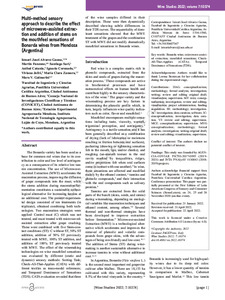Por favor, use este identificador para citar o enlazar este ítem:
https://repositorio.uca.edu.ar/handle/123456789/15179| Título: | Multi-method sensory approach to describe the effect of microwave-assisted extraction and addition of stems on the mouthfeel sensations of Bonarda wines from Mendoza (Argentina) | Autor: | Álvarez Gaona, Izmari Jasel Fanzone, Martín Sari, Santiago Catania, Aníbal Coronado, Ignacio Jofré, Viviana Patricia Zamora, María Clara Galmarini, Mara Virginia |
Palabras clave: | VINO TINTO; VINO BONARDA; EXTRACCION ASISTIDA POR MICROONDAS; SENSACIONES EN LA BOCA; CATA; TEMPORAL DOMINANCIA DE LAS SENSACIONES | Fecha de publicación: | 2022 | Editorial: | PAGEPress | Cita: | Álvarez Gaona, I. J. et al. Multi-method sensory approach to describe the effect of microwave-assisted extraction and addition of stems on the mouthfeel sensations of Bonarda wines from Mendoza (Argentina) [en línea]. Wine Studies. 2022 (7:10374). doi: 10.4081/ws.2022.10374. Disponible en: https://repositorio.uca.edu.ar/handle/123456789/15179 | Resumen: | Abstract: The Bonarda variety has been used as a base for common red wines due to its contribution to color and low level of astringency as a consequence of its relative low tannin concentration. The use of MicrowaveAssisted Extraction (MWE) accelerates the maceration process, improving the diffusion of grape compounds into the must, while the stems addition during maceration/fermentation constitutes a sustainable technological alternative for increasing tannins at no additional cost. The present experimental design consisted of ten treatments (in triplicate), obtained combining both technologies. Two maceration strategies were applied: Control must (C) which was not treated, and must treated with microwavedassisted extraction after grape crushing. These were combined with five Stem-contact conditions (ST): C without ST, 50% ST addition, addition of 50% ST previously treated with MWE, 100% ST addition, and addition of 100% ST previously treated with MWE. The effect of the winemaking technologies on wine mouthfeel sensations was evaluated by different (static and dynamic) sensory methods: Sorting Task; Check-All-That-Applies (CATA) with different textiles as trans-modal references; and Temporal Dominance of Sensations (TDS). CATA evaluation revealed that three of the wine samples differed in their description. These were then dynamically described showing subtle differences in their TDS curves. The sequentiality of dominant sensations showed that the MWE treatment of the grapes and the combination ST with MWE did not modify dramatically mouthfeel sensations in Bonarda wines. | Cobertura Espacial: | Mendoza (Argentina : Provincia) | URI: | https://repositorio.uca.edu.ar/handle/123456789/15179 | ISSN: | 2039-4438 2039-4446 (online) |
Disciplina: | CIENCIAS AGRARIAS | DOI: | 10.4081/ws.2022.10374 | Derechos: | Acceso abierto | Fuente: | Wine Studies Vol.7:10374, 2022 |
| Aparece en las colecciones: | Artículos |
Ficheros en este ítem:
| Fichero | Descripción | Tamaño | Formato | |
|---|---|---|---|---|
| multi-method-sensory-approach.pdf | 492,57 kB | Adobe PDF |  Visualizar/Abrir |
Visualizaciones de página(s)
83
comprobado en 27-abr-2024
Descarga(s)
49
comprobado en 27-abr-2024
Google ScholarTM
Ver en Google Scholar
Altmetric
Altmetric
Este ítem está sujeto a una Licencia Creative Commons

